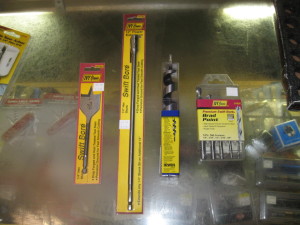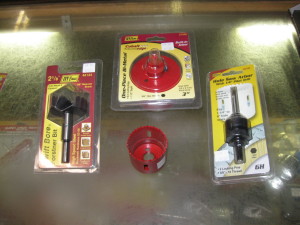I went to the “Spring” consignment auction this morning and as I poked around under the piles of snow covering the items that were lined up for sale, I pondered the meaning of Spring in Northeast Ohio. I decided to come up to the store instead of hanging around the auction all morning. I promised to write something about wood drilling to follow up the article that I wrote last week concerning metal drilling.
Drilling holes in wood is in some ways much easier that drilling holes in metal. Wood, even hardwoods, are much softer that metal, so there are no problems concerning special alloy steels for bits. Plain carbon steel works fine, although once again high speed steel is more common. The finer points of wood drilling have to do with the different types of drills available, and the right one to use in each instance. Regular metal drilling bits work fine for small holes, but you have to back the bits out regularly to keep the wood chips from jamming the bit. Because wood has grain, it will splinter some when the hole goes all the way through your workpiece. The old trick to prevent this is to place your work on top of a block of waste wood and drill into the second piece. This will keep the good one from splintering out. Specially pointed drills called “brad point” are made to reduce splintering, and are a handy addition to your shop if you do a lot of woodworking.
Wood drilling gets interesting when the diameter of the holes gets larger. Drilling 1” or bigger holes in metal is not common for the home handyman, but large holes in woodworking are a regular occurrence. Larger holes are often drilled with a flat tipped bit called a spade or paddle bit. These will chew their way through wood easily and are often used to drill through joists and rafters to run electrical wiring. They don’t always leave the neatest hole though, so the trick with them is to drill until just the very tip of the drill starts to show through from the other side, and then use that location to finish drilling from there. Spade bits come in standard 6” lengths as well as longer 16” ones. Handy extensions are also available in 12” lengths for deeper drilling. It’s not really common to drill a hole that deep, but it’s usually a matter of lack of clearance to get the drill motor close enough to where you need to drill your hole.
Really big holes for pipes and such are the realm of what are called hole saws. These are literally saw-type blades bent in a circle and welded to a center, They will drill large holes up to 4” or more in diameter, and rely on a center drill to keep them cutting straight when starting. The bit will saw out a circular plug of material, which has to be removed from the drill. These have a heavy arbor in the middle to attach to the drill chuck, and come in both all-in-one, and removable arbor styles. You pays your money and you takes your choice. Hole saws can also be used to drill metal, but because of the heavy duty nature of the drilling, a drill press is usually used instead of a portable tool.
In specialty woodworking a flat bottomed hole is often needed, this is where Forstner bits come in. These have a point to start, and then steel “wings” that reach out to the sides to do the cutting. They run from 1/4” to over 2” in size and leave a clean, flat bottomed hole, useful for setting glue dowels and many other things. The 1-3/8” bit is often used to drill the relief hole needed to mount European-style hidden cabinet hinges. Forstner bits come with either plain points for drill press work, or screw tip self feeding tips for field drilling. The last type of bit is the auger bit, these look like big corkscrews, and are used in heavy duty drilling. They are not used a lot anymore, but are still made.
That about covers it for drilling, now we just have to wait for the snow to melt off so we can get out to our workshops to get something done.



